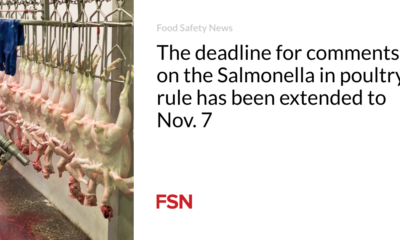Food
Finland assesses the pros and cons of the Salmonella control program

Finland’s Salmonella control program for pigs helps protect consumers, but there is room for improvement, according to an assessment.
Ruokavirasto (the Finnish Food Authority) evaluated the public health and cost impacts of the national Salmonella control program for pigs.
It is estimated that salmonella in domestic pork causes occasional cases of salmonellosis every year. If pigs infected with Salmonella were not removed from the production chain, it is predicted that the number of diseases would quadruple. The analysis has shown this over time, the prevalence of the pathogen in pigs would also increase.
If the prevalence of Salmonella in the production chain were comparable to the EU average, 40 to 100 people would become ill in Finland every year. If the spread of Salmonella in the chain were not prevented at all and the pathogen were present in 20 percent of companies, there would be 400 cases annually.
Assessing the impact of different options
Special guarantees would expire if the current control program were to end, resulting in an increase in the annual number of diseases linked to imported pork from 50 to 150 cases. Stricter requirements should also be imposed on pork exported from Finland than is currently the case.
Based on the control program, the European Commission has granted Finland a special status so that meat of foreign origin, sold fresh, must be certified Salmonella-free before arriving in the country.
The national Salmonella control program for pigs has been followed in Finland since 1995. The detection of Salmonella always leads to risk management measures. The cost of the program has been largely borne by the business community, with the help of insurance coverage. However, costs have risen in recent years, weakening the financial situation of farms.
The assessment covered the current public health and economic situation, and scenarios where the monitoring program would be dropped or based on serological samples, as in Denmark.
The main benefit of the current program is the low incidence of illness and medical costs associated with Salmonella.
The largest costs arise from cleaning, disinfection and other measures established by authorities. These costs are unevenly distributed among the operators. If the control program were abandoned or modified, eradication costs would decrease, but disease costs would increase.
However, Ruokavirasto recommended reorganizing the pork production chain and Salmonella monitoring to ensure food safety, as required by legislation.
Revised job loss announcement
Ruokavirasto also reported that the previously estimated number of job losses at the agency has decreased as it has found other ways to save money.
The current forecast for layoffs is around 50 people, up from 93 in May. They will be implemented at the end of November.
During the remainder of the year, the agency will lay off all its staff in two-week phases, with the exception of those performing meat inspection duties at slaughterhouses and related locations.
By reducing operational costs, it has been possible to reduce staff reductions. The agency saves by reducing investments, purchases of services and travel costs and by not filling vacancies.
Due to job losses and other savings, a decline in service levels cannot be completely avoided and delays in customer service may occur. However, the agency says it strives to serve customers as best as possible.
The measures were necessary because the agency’s expenditure from 2024 to 2028 exceeds the resources from the state budget and from revenues. Ruokavirasto employs approximately 1,000 experts in various fields, spread over 20 locations.
(To sign up for a free subscription to Food Safety News, click here.)













